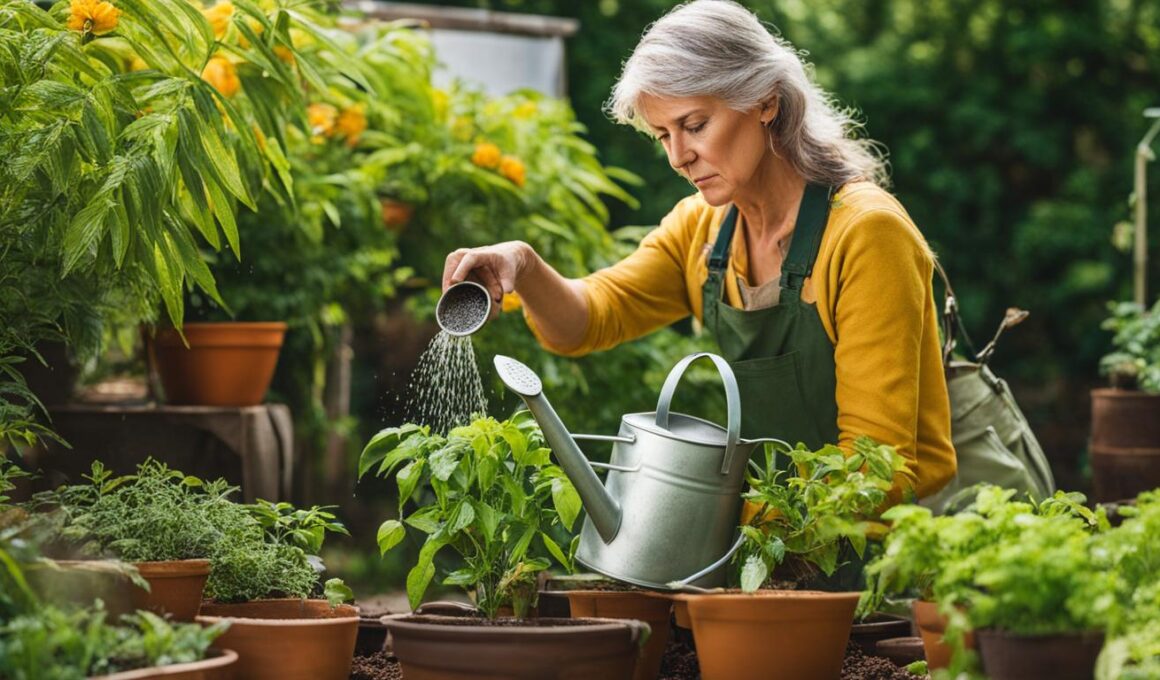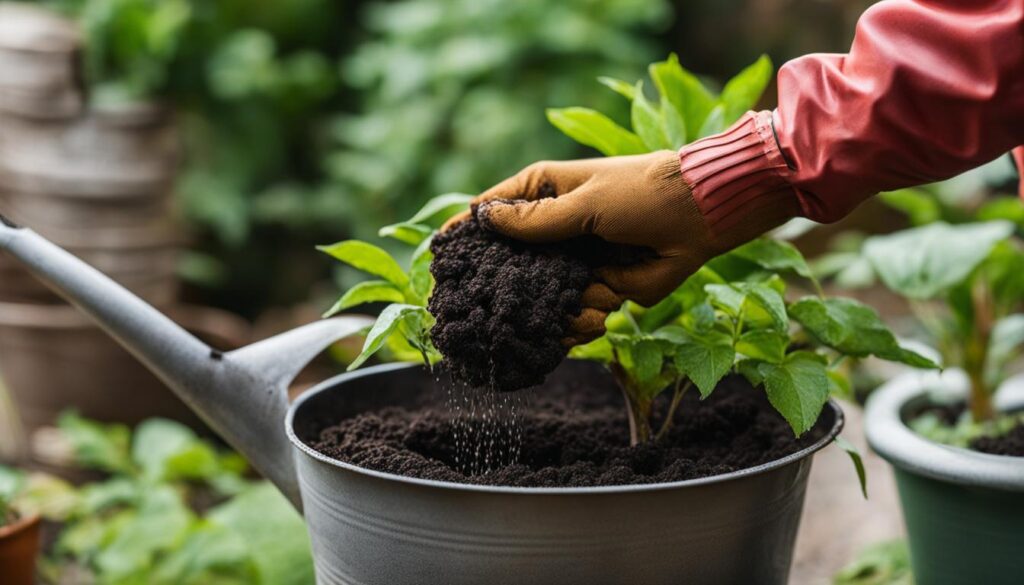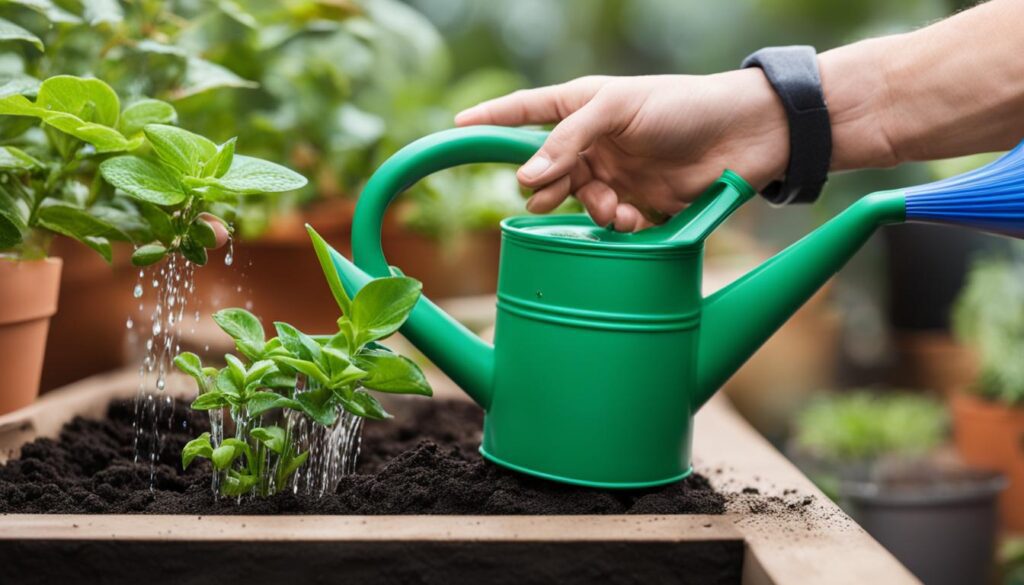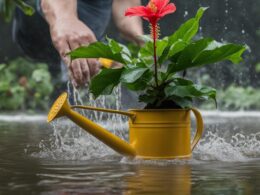Overwatering is a common mistake that many gardeners make, and it can lead to stressed and drooping plants. Recognizing the signs of overwatering is the first step in reviving these plants and restoring their health.
Symptoms include yellowing or browning leaves, wilting, and damp or foul-smelling soil. To address overwatering, you should stop watering the plant, improve drainage by elevating the pot or using one with drainage holes, use well-draining soil, and add accessories like lava rocks for better water absorption. Signs of improvement include new growth, healthier leaves, and a drier soil surface.
Key Takeaways:
- Recognize the signs of overwatering, such as yellowing leaves and wilting.
- Stop watering the plant and improve drainage for better plant health.
- Use well-draining soil and add accessories like lava rocks.
- Look for signs of improvement, such as new growth and healthier leaves.
- Adjust your watering routine based on the plant’s watering needs and environmental conditions.
Understanding Plant Watering Needs
When it comes to watering your plants, one size does not fit all. Different plants have different watering needs based on their natural climate, growth stage, and current environmental conditions. Understanding these factors is key to providing the right amount of water for your plants to thrive.
A good rule of thumb is to water your plants when the top inch of soil feels dry to the touch. However, this can vary depending on the type of plant and its specific requirements. Desert plants, such as succulents, are adapted to arid conditions and require less water due to their ability to store water in their leaves and stems. On the other hand, tropical plants typically have higher water needs and may require more frequent watering.
To determine if your plant needs water, you can perform a simple soil moisture test. Insert your finger into the soil up to your first knuckle. If the soil feels dry at that depth, it’s time to water your plant. Alternatively, you can use a moisture meter to get an accurate reading of the soil moisture level.
Remember that watering needs can also vary based on the weather, season, and growth patterns of your plants. In hotter weather or during periods of fast growth, plants may require more frequent watering. On the other hand, in cooler temperatures or during the dormant season, watering can be spaced out. Monitoring your plants and adjusting your watering routine accordingly will help ensure their overall health and vitality.
The Importance of Proper Watering Frequency:
- Watering needs vary based on plant type and environmental conditions.
- Check the soil moisture level regularly to determine when to water.
- Use the finger test or a moisture meter to accurately assess soil moisture.
- Adjust watering frequency based on weather, season, and plant growth patterns.
“Understanding the specific watering needs of your plants is essential for their overall health and well-being. By paying attention to factors like natural climate, growth stage, and environmental conditions, you can provide the right amount of water at the right time. Remember to monitor your plants closely and adjust your watering routine as needed.”
Signs of Overwatering
If you’re worried that you may be overwatering your outdoor plants, there are several signs you can look out for. These indicators can help you identify if your plants are suffering from too much moisture:
- Yellow Leaves: One of the most common signs of overwatering is yellowing leaves. If the leaves of your plants are turning yellow, it could be a sign that they are receiving more water than they need.
- Wilting: Overwatered plants may also show signs of wilting. This can be confusing since wilting is often associated with underwatering. However, when a plant is overwatered, its roots may become waterlogged, preventing them from absorbing oxygen properly. As a result, the plant may wilt even though the soil is moist.
- Slowed Growth: If your plants are growing at a slower pace than usual, it could be due to overwatering. Too much water can interfere with nutrient absorption and root development, leading to stunted growth.
- Mold and Fungus: Excessive moisture creates a favorable environment for mold and fungus to thrive. If you notice mold or fungus growing on the soil surface or on the leaves of your plants, it may indicate overwatering.
Keep a close eye on your plants and look out for these signs. If you observe multiple symptoms, chances are your plants are being overwatered. It’s important to address the issue promptly to prevent further damage.
Fixing Overwatered Plants
Overwatering your plants can lead to a host of problems, but don’t worry – there are steps you can take to fix the issue and bring your plants back to health. The first and most important step is to stop watering the plants immediately. This will allow the soil to dry out and prevent further damage to the roots.
Next, you’ll want to improve the drainage of your plants. Elevating the pot or using a pot with drainage holes can help excess water escape and prevent water from sitting in the soil. Additionally, using a well-draining soil mix will ensure that water doesn’t get trapped around the roots.
Optimizing the environment for your overwatered plants is also crucial. Make sure to provide adequate sunlight, as this will help dry out the soil. If the air is humid, consider using a dehumidifier or increasing air circulation around the plants. Another helpful tip is to increase the temperature slightly, as warmer temperatures can aid in drying out the soil.
Here are some key steps to fix overwatered plants:
- Stop watering the plants immediately.
- Improve drainage by elevating the pot or using one with drainage holes.
- Use a well-draining soil mix.
- Optimize the environment by providing adequate sunlight, dehumidifying the air, and increasing air circulation and heat.
By following these steps, you can give your overwatered plants a fighting chance for recovery. Remember to monitor their progress closely and make adjustments as needed. With a little patience and the right care, your plants will be thriving again in no time!
Adjusting Watering Routine
Proper watering is crucial for the health of your outdoor plants. By adjusting your watering routine, you can prevent overwatering and ensure that your plants thrive. Here are some important tips to help you find the right balance:
- Check soil moisture: Before watering, check the moisture level of the soil. Stick your finger about an inch into the soil. If it feels dry, it’s time to water. If it feels moist, hold off on watering for now.
- Establish a watering schedule: Create a watering schedule based on the specific needs of your plants. Consider factors such as the type of plant, season, and weather conditions. For example, plants may need less water during cooler months or when it’s raining.
- Water deeply and less frequently: It’s better to water deeply and less often than to water lightly and frequently. This encourages deep root growth and helps plants become more drought-tolerant.
- Use mulch: Apply a layer of organic mulch around your plants to help retain moisture in the soil. This can reduce the need for frequent watering and protect the roots from extreme temperatures.
Quote:
“Finding the right watering routine can make a significant difference in the overall health and resilience of your outdoor plants. By adjusting your watering schedule and being mindful of the moisture levels in the soil, you can ensure that your plants receive the proper amount of water they need to thrive.”
Keep in mind that different plants have different water requirements, so it’s important to research the specific needs of each plant in your garden. By paying attention to soil moisture, establishing a watering schedule, watering deeply, and using mulch, you can provide your outdoor plants with the proper amount of water they need to stay healthy and vibrant.
Remember, the key to proper watering is finding the right balance. By adjusting your watering routine and being attentive to your plants’ needs, you can help them thrive and avoid the common problem of overwatering.
Providing Proper Care and Nutrients
When it comes to nurturing overwatered plants back to health, providing proper care and nutrients is essential. However, it’s important to approach this step with caution and patience to avoid overwhelming the plant.
Initially, it’s best to avoid fertilization and allow the plant’s root system to recover and regain strength. This period of rest will help the plant focus on repairing any damage caused by overwatering. As you observe signs of improvement, such as new growth and healthier leaves, you can gradually introduce a balanced liquid fertilizer.
Remember, it’s crucial to dilute the fertilizer to half or a quarter of the recommended strength to prevent overwhelming the plant with excessive nutrients. This gradual approach will give the plant time to adjust and prevent any further stress. Regular monitoring of the plant’s progress is vital to ensure its continued recovery.
As you continue to provide care for your overwatered plants, keep in mind that each plant has unique needs. Observe how your plants respond to different care techniques and make adjustments accordingly. By nurturing your plants with proper care and nutrients, you are giving them the best chance to thrive once again.
Conclusion
Overwatering is a common mistake that can harm outdoor plants, but it can be remedied with the right knowledge and steps. By recognizing the signs of overwatering, improving drainage, adjusting watering routines, and providing proper care and nutrients, you can revive overwatered plants and help them thrive again. Remember to be patient and monitor the plant’s progress closely. Learning from mistakes and adapting your care routine will help prevent future overwatering incidents and maintain the health and beauty of your outdoor plants.
How Can I Tell If My Outdoor Plants Are Being Overwatered, and How Can I Fix It?
If you notice wilting, yellowing leaves, or slow growth, your outdoor plants may be suffering from over watering. To fix it, allow the soil to dry out before watering again, improve drainage, and consider repotting in well-draining soil. These steps can help prevent over watering outdoor plants.
FAQ
How do I know if my plants are being overwatered?
Look for signs such as yellow or brown spots on the leaves, wilting, slowed growth, the presence of mold or fungus, and constantly damp soil.
What should I do if I suspect my plants are overwatered?
The first step is to stop watering them until the soil has dried out. Improve drainage by elevating the pot, ensuring proper drainage holes, and using a well-draining soil mix. Optimize the plant’s environment by increasing light, dehumidifying the air, and improving air circulation and heat.
How do I treat root rot caused by overwatering?
If root rot has occurred, remove the plant from the soil, cut away damaged roots, clean the roots with a fungicide solution, and repot the plant in fresh soil.
How can I prevent overwatering in the future?
Adjust your watering routine based on the weather, season, and plant growth patterns. Check soil moisture using the finger test or a moisture meter. Space out waterings in the winter and water more in hot weather or during periods of fast growth.
When can I start fertilizing my overwatered plants?
Avoid fertilization initially to allow the plant’s root system to recover. As the plant shows signs of improvement and new growth, gradually introduce a balanced liquid fertilizer, but dilute it to half or a quarter of the recommended strength.
How long does it take for overwatered plants to recover?
The recovery time can vary depending on the level of overwatering and the plant species. Regular monitoring of the plant’s progress is essential to ensure its continued recovery.












